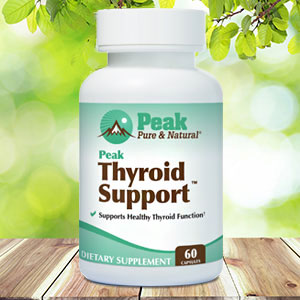Get Easy Health Digest™ in your inbox and don’t miss a thing when you subscribe today. Plus, get the free bonus report, Mother Nature’s Tips, Tricks and Remedies for Cholesterol, Blood Pressure & Blood Sugar as my way of saying welcome to the community!
When it feels like a UTI but it’s not

Interstitial cystitis (IC), the condition I wrote about in Is it a UTI or something else, can seem like a chronic urinary tract infection.
But unlike a UTI, no bacterial infection is present. All the other annoying symptoms are however — especially the frequent and often painful urination.
It often hits around the age of 40 and nearly one million Americans suffer from it — 90 percent of them are women. But there is relief…
How most doctors treat IC
A urologist will have mainstream medications for the treatment of interstitial cystitis. These often do work, but because IC has several contributing causes, the prescription medications or surgical interventions have variable success rates.
Here is a quick list of what your doctor will typically prescribe for IC:
- Anti-inflammatories (Ibuprofen) or narcotic pain relievers
- Tricyclic antidepressants such as amitriptyline (Elavil) or imipramine (Tofranil)
- Topical medications: lidocaine patches, vaginal/rectal diazepam (Valium), topical amitriptyline
- Pentosan (Elmiron): thought to coat and protect the bladder wall
- Alpha blockers (Flomax)
- Anti-histamines: H1 blockers (Claritin) or H2 blockers (Tagamet)
- Amphetamines (methylphenidate)
- Nerve modulators (Neurontin, Lyrica)
- Leukotriene inhibitors (Singulair)—based on a small study
- Immunosuppressants: cyclosporine, mycophenolate (CellCept), and others
- Urinary tract antispasmodics (Detrol)
- Urinary antacids (potassium or sodium citrate, tricitrates)
- Bladder instillationswith DMSO, sodium hyaluronate, Elmiron, or heparin
Here are some surgical interventions used:
- Botox injections
- Laser surgery
Effective Natural treatments — without the side effects
In the pursuit of natural treatment for IC, you’ll first want to minimize those contributing causes, I detailed in Is it a UTI or something else:
- A shift in vaginal pH
- A change of the predominate vaginal bacteria or yeast
- An irritation around the urethral opening
- Holding urine too long while traveling, working, etc.
To help you identify these, take a symptom diary, noting foods, activities, emotions, etc. surrounding your symptom flares.
If the event of any of those causes being a contributor to interstitial cystitis, these changes and remedies should help you gain relief:
- Avoid foods that are acidic irritants to your bladder which may include: alcohol, coffee, diet soda, cranberry and citric juices, tomatoes, chocolate, and maybe even lemons. Drink lots of water to dilute urine.
- Identify food sensitivities: an elimination diet will be most accurate to identify culprit foods. Also, learn more about NAET— Nambudripad’s allergy elimination technique, known to reset your subtle energies to eliminate the allergic response.
- Be super careful with the consumption of sugars, starches, and processed foods, especially breads and yeast-containing foods.
- If yeast is thought to play a role, ask your doctor for Diflucan (fluconazole); then follow this with a quality probiotic and an alkaline diet (low sugar and meat, high in fresh produce)
- Wear a pelvic support.
- Neuromodulation using TENS (transcutaneous electrical nerve stimulation) to increase blood flow, strengthen bladder wall muscles,and help block pain.
- Biofeedback bladder training (briefly described in Is it a UTI or something else): a therapist places a probe into the vagina/anus, or places electrodes around these areas, to measure your pelvic floor muscles. You practice relaxing these. This is the opposite of Kegel’s (contraction) exercises.
- Herbal remedies: marshmallow root; Aloe Vera pills (Aloe liquid is reported to have citric acid as a preservative that will irritate the bladder); Turmeric at 800 mg three times daily for pain relief; boswellia
- Manual soft massage, cold pack, or heating pad/hot water bottle directly to the perineum
- Yoga and Pilates can strengthen muscles surrounding the perineum
- Acupuncture or energy reduce impulses of nerves involved the pain of IC
- N-Acetyl Glucosamine (NAG) with MSM or SAM-e is thought to be anti-inflammatory and pain relieving on the bladder wall.
- L-Arginine is known to increase nitric oxide (NO) levels, often found to be low in patients with IC. A small study showed that 1.5 gm of L-arginine taken by mouth daily for 6 months significantly improved symptoms in 10 out of 10 patients. 1 And it is known that L-Citrulline can boost nitric oxide even more significantly.
- Omega-3 oils at 3,000 to 6,000 mg daily as a supplement
- Caprylic acid is an anti-fungal fatty acid extracted from plants such as coconut oil. Taken along with Omega-3 Fish Oil, it has been shown to reduce IC symptoms significantly. 2 It would be reasonable to take 500 mg twice a day for 3 days, then 1,000 mg three times a day along with Diflucan daily for a week.
Painful sex from IC
It is reported that 50 to 85 percent of women with interstitial cystitis have vaginal, vulvar, or pelvic region pain with sexual activity. This kind of pain promotes low sexual desire and emotional tension, resulting also in depression or relationship dysfunction. So, consider alternatives to intercourse if it is painful, including taking it slow, sensuous massage, and other ways to share affection.
To feeling good in health,
Michael Cutler, M.D.
Easy Health Options
[1] Smith S, Wheeler M, Foster H, Weiss H. Improvement in interstitial cystitis symptom scores during treatment with oral L-Arginine. J Urol 1997;158:703. Found online at:
[2] Omura Y, et al. Caprylic acid in the effective treatment of intractable medical problems of frequent urination, incontinence, chronic upper respiratory infection, root canalled tooth infection, ALS, etc., caused by asbestos & mixed infections of Candida albicans, Helicobacter pylori & cytomegalovirus with or without other microorganisms & mercury. Acupunct Electrother Res. 2011;36(1-2):19-64. Found online at: http://www.ncbi.nlm.nih.gov/pubmed/21830350













